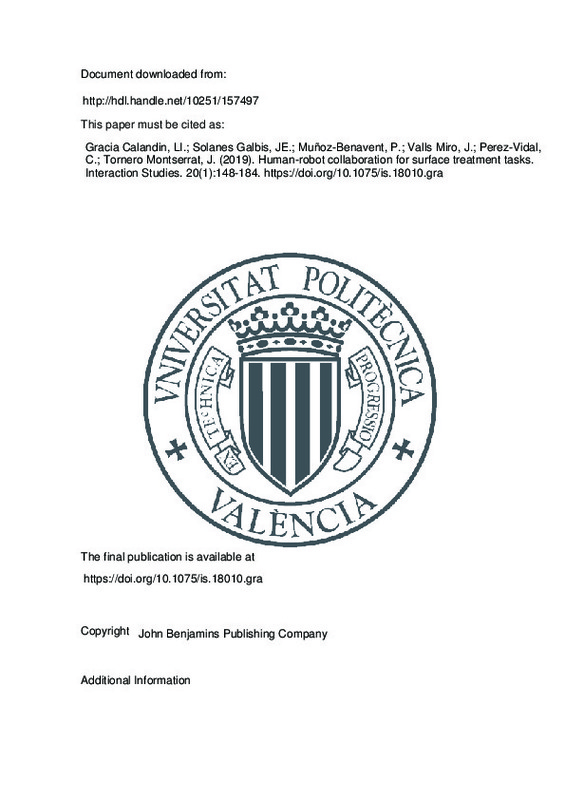Angel-Fernandez, J. M., & Bonarini, A. (2016). Robots Showing Emotions. Interaction Studies / Social Behaviour and Communication in Biological and Artificial Systems, 17(3), 408-437. doi:10.1075/is.17.3.06ang
Arnal, L., Solanes, J. E., Molina, J., & Tornero, J. (2017). Detecting dings and dents on specular car body surfaces based on optical flow. Journal of Manufacturing Systems, 45, 306-321. doi:10.1016/j.jmsy.2017.07.006
Chiaverini, S., Oriolo, G., & Walker, I. D. (2008). Kinematically Redundant Manipulators. Springer Handbook of Robotics, 245-268. doi:10.1007/978-3-540-30301-5_12
[+]
Angel-Fernandez, J. M., & Bonarini, A. (2016). Robots Showing Emotions. Interaction Studies / Social Behaviour and Communication in Biological and Artificial Systems, 17(3), 408-437. doi:10.1075/is.17.3.06ang
Arnal, L., Solanes, J. E., Molina, J., & Tornero, J. (2017). Detecting dings and dents on specular car body surfaces based on optical flow. Journal of Manufacturing Systems, 45, 306-321. doi:10.1016/j.jmsy.2017.07.006
Chiaverini, S., Oriolo, G., & Walker, I. D. (2008). Kinematically Redundant Manipulators. Springer Handbook of Robotics, 245-268. doi:10.1007/978-3-540-30301-5_12
Dimeas, F., & Aspragathos, N. (2016). Online Stability in Human-Robot Cooperation with Admittance Control. IEEE Transactions on Haptics, 9(2), 267-278. doi:10.1109/toh.2016.2518670
Edwards, C., & Spurgeon, S. (1998). Sliding Mode Control. doi:10.1201/9781498701822
Engeberg, E. D., Meek, S. G., & Minor, M. A. (2008). Hybrid Force–Velocity Sliding Mode Control of a Prosthetic Hand. IEEE Transactions on Biomedical Engineering, 55(5), 1572-1581. doi:10.1109/tbme.2007.914672
Etzioni, A., & Etzioni, O. (2017). The ethics of robotic caregivers. Interaction Studies / Social Behaviour and Communication in Biological and Artificial Systems, 18(2), 174-190. doi:10.1075/is.18.2.02etz
De Graaf, M. M. A., Ben Allouch, S., & van Dijk, J. A. G. M. (2016). Long-term evaluation of a social robot in real homes. Interaction Studies / Social Behaviour and Communication in Biological and Artificial Systems, 17(3), 461-490. doi:10.1075/is.17.3.08deg
Jlassi, S., Tliba, S., & Chitour, Y. (2014). An event-controlled online trajectory generator based on the human-robot interaction force processing. Industrial Robot: An International Journal, 41(1), 15-25. doi:10.1108/ir-01-2013-317
Khan, A. M., Yun, D., Zuhaib, K. M., Iqbal, J., Yan, R.-J., Khan, F., & Han, C. (2017). Estimation of Desired Motion Intention and compliance control for upper limb assist exoskeleton. International Journal of Control, Automation and Systems, 15(2), 802-814. doi:10.1007/s12555-015-0151-7
Levant, A. (2003). Higher-order sliding modes, differentiation and output-feedback control. International Journal of Control, 76(9-10), 924-941. doi:10.1080/0020717031000099029
Levant, A. (2005). Quasi-continuous high-order sliding-mode controllers. IEEE Transactions on Automatic Control, 50(11), 1812-1816. doi:10.1109/tac.2005.858646
Martínez, S. S., Ortega, J. G., García, J. G., García, A. S., & Estévez, E. E. (2013). An industrial vision system for surface quality inspection of transparent parts. The International Journal of Advanced Manufacturing Technology, 68(5-8), 1123-1136. doi:10.1007/s00170-013-4904-2
Massoud, A. T., ElMaraghy, H. A., & Lahdhiri, T. (1999). Journal of Intelligent and Robotic Systems, 25(3), 227-254. doi:10.1023/a:1008099522350
Mitra, A., & Behera, L. (2015). Development of a Fuzzy Sliding Mode Controller with adaptive tuning technique for a MRI guided robot in the human vasculature. 2015 IEEE 13th International Conference on Industrial Informatics (INDIN). doi:10.1109/indin.2015.7281763
Molina, J., Solanes, J. E., Arnal, L., & Tornero, J. (2017). On the detection of defects on specular car body surfaces. Robotics and Computer-Integrated Manufacturing, 48, 263-278. doi:10.1016/j.rcim.2017.04.009
Nakamura, Y., Hanafusa, H., & Yoshikawa, T. (1987). Task-Priority Based Redundancy Control of Robot Manipulators. The International Journal of Robotics Research, 6(2), 3-15. doi:10.1177/027836498700600201
Ortaç, G., Bilgi, A. S., Taşdemir, K., & Kalkan, H. (2016). A hyperspectral imaging based control system for quality assessment of dried figs. Computers and Electronics in Agriculture, 130, 38-47. doi:10.1016/j.compag.2016.10.001
Papadopoulos, F., Küster, D., Corrigan, L. J., Kappas, A., & Castellano, G. (2016). Do relative positions and proxemics affect the engagement in a Human-Robot collaborative scenario? Interaction Studies / Social Behaviour and Communication in Biological and Artificial Systems, 17(3), 321-347. doi:10.1075/is.17.3.01pap
Roswell, A., Xi, F. (Jeff), & Liu, G. (2006). Modelling and analysis of contact stress for automated polishing. International Journal of Machine Tools and Manufacture, 46(3-4), 424-435. doi:10.1016/j.ijmachtools.2005.05.006
Sakaino, S., & Ohnishi, K. (2006). Sliding Mode Control Based on Position Control for Contact Motion Applied to Hopping Robot. 2006 IEEE International Conference on Industrial Technology. doi:10.1109/icit.2006.372347
Shi, Y., Zheng, D., Hu, L., Wang, Y., & Wang, L. (2011). NC polishing of aspheric surfaces under control of constant pressure using a magnetorheological torque servo. The International Journal of Advanced Manufacturing Technology, 58(9-12), 1061-1073. doi:10.1007/s00170-011-3445-9
Siciliano, B., Sciavicco, L., Villani, L., & Oriolo, G. (2009). Robotics. Advanced Textbooks in Control and Signal Processing. doi:10.1007/978-1-84628-642-1
Tian, F., Li, Z., Lv, C., & Liu, G. (2016). Polishing pressure investigations of robot automatic polishing on curved surfaces. The International Journal of Advanced Manufacturing Technology, 87(1-4), 639-646. doi:10.1007/s00170-016-8527-2
Tornero, J., Armesto, L., Mora, M. C., Monteś, N., Herráez, Á., & Asensio, J. (2012). Detección de Defectos en Carrocerías de Vehículos Basado en Visión Artificial: Diseño e Implantación. Revista Iberoamericana de Automática e Informática Industrial RIAI, 9(1), 93-104. doi:10.1016/j.riai.2011.11.010
Utkin, V., Guldner, J., & Shi, J. (2017). Sliding Mode Control in Electro-Mechanical Systems. doi:10.1201/9781420065619
Vlachos, E., Jochum, E., & Demers, L.-P. (2016). The Effects of Exposure to Different Social Robots on Attitudes toward Preferences. Interaction Studies / Social Behaviour and Communication in Biological and Artificial Systems, 17(3), 390-404. doi:10.1075/is.17.3.04vla
Wu, Q., Wang, X., Du, F., & Zhu, Q. (2015). Fuzzy sliding mode control of an upper limb exoskeleton for robot-assisted rehabilitation. 2015 IEEE International Symposium on Medical Measurements and Applications (MeMeA) Proceedings. doi:10.1109/memea.2015.7145246
Yun, D., Khan, A. M., Yan, R.-J., Ji, Y., Jang, H., Iqbal, J., … Han, C. (2016). Handling subject arm uncertainties for upper limb rehabilitation robot using robust sliding mode control. International Journal of Precision Engineering and Manufacturing, 17(3), 355-362. doi:10.1007/s12541-016-0044-6
ZHOU, J., ZHOU, Z., & AI, Q. (2016). Impedance Control of the Rehabilitation Robot Based on Sliding Mode Control. Mechanical Engineering and Control Systems. doi:10.1142/9789814740616_0030
[-]







![[Cerrado]](/themes/UPV/images/candado.png)


